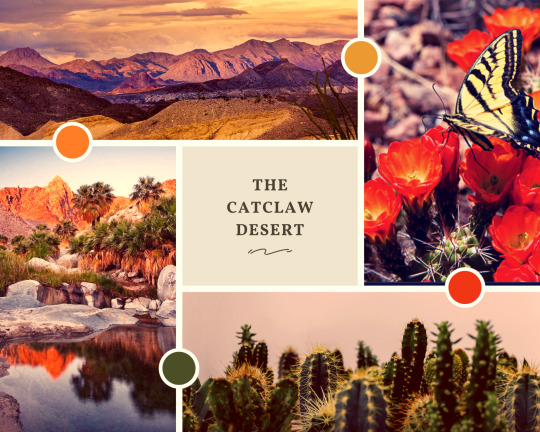#if i slipped up. esp when it comes to mexican culture pls feel free to tell me
Explore tagged Tumblr posts
Photo

Hello friends! For @mappingthearcana‘s worldbuilding event, I’ll be talking about Nopal, the Catclaw Desert and the Bulan Mountains.
PART ONE:
i. THE CATCLAW DESERT
ii. THE BULAN MOUNTAINS
PART TWO:
iii. NOPAL
My main focus is Nopal itself, but for the first post, we’ll be taking a look at the Catclaw Desert and the Bulan mountains, to understand how the three of them affect and relate to each other.
Much of this is inspired by the Chihuahuan Desert and Mexican culture, originally inspired by this post on how Nopal is similar to Northern Mexico and Southwestern US.
Feel free to point out any errors or anything~
i. 🏜️ THE CATCLAW DESERT 🌵🦋

- A subtropical desert that receives infrequent bouts of rainfall. The climate tends to be consistently dry, receiving a little more rainfall in winter
- However, there are semi-arid patches here and there, particularly closer to the mountains, where the effects of changing seasons are more apparent, like frost
- Throughout the desert, spring is usually signaled by the coming of flutters and flutters of butterflies, nicknamed the Great Butterfly Rains, where migrating butterflies pause at Catclaw
- Oases are scattered throughout the desert, typically populated by the many nomadic tribes of the desert
- The tribes might have their disagreements, but overall, they tend to cooperate and assist one another where they can. After all, a single grain of sand is no desert, just as no single person can survive alone in the harsh climate of Catclaw
- Merchant caravans traveling through the deserts are uncommon, due to the harsh conditions and maritime travel generally being more favored
- Nopal is the biggest permanent settlement in all of the Catclaw Desert
ii. 🌙⛰️ THE BULAN MOUNTAINS 🌽

- While the Bulan mountains is a semi-arid place, it experiences far more rainfall than its desert neighbor.
- On top of that, there is its large main river, often called the Verde river, due to the rich soil by the riverbanks that allow for plantlife and crops
- The river weaves through the entire length of the mountains themselves, creating a river canyon, and branches off into smaller streams. There are also small box canyons here and there
- Most of the larger settlements are focused around the rivers and streams, to help sustain crops and livestock
- Landslides and erosions can be a frequent problem during heavy rainfall. To prevent this, it is common practice to carry out intercropping or forestry activities, mostly along areas with little vegetation
- Maize, corn and wheat are common staple crops, among a variety of others. The Bulan Mountains are particularly well known for their Bluemoon corn, which comes in different colors
- Latifundias are the center of agricultural activities, whether it’s for management of crops or animal rearing and are either community-owned or privately owned.
- There is no limit to the number of latifundias in one area and the layout is reminiscent of our world’s haciendas
- Like Vesuvia, the settlements of the Bulan mountains have complex aqueduct systems, both for agricultural and domestic purposes. Indoor plumbing is not unusual, even in smaller villages
- Stucco is a common building material, and houses are often painted in bold, bright colors, helping to reflect some of the heat
- Occasionally, nomadic tribes from Catclaw will migrate to the Bulan mountains, especially in the cases where their oasis or local water source has dried up.
- Recent droughts and the lack of water in even Nopal has led to more tribes moving to the mountains, establishing new routes and camps
- River travel is one of the main modes of transportation, particularly for these tribes as they journey through the mountains. They often carry out trade with the towns and villages scattered throughout the mountains
–––––––––––––
- At the foot of the mountains, along the coast, efforts have been put into by several towns to establish a permanent port known as the Bintang port
- There is merchant activity, both within the mountains themselves and with the outside. This is mainly with Prakra and the Republic of Galibrada
- As a result, there’s quite a bit of cultural exchange. Silk can be found in many towns, as well as Prakran curry and naan bread
- Traveling to the other side of the mountains, towards the south, is often done via maritime travel rather than traveling through the desert
- On the rare chance they do travel by land, Nopal is often a stopping point
–––––––––––––
Thanks for reading! 🥰🥰 Look forward to Part Two~
#mapthearcana#the arcana game#the arcana headcanons#the arcana meta#the catclaw desert#the bulan mountains#the arcana fan edits#i had loads of fun coming up w these. i hope yall enjoy them!#if i slipped up. esp when it comes to mexican culture pls feel free to tell me#mimi's originals#writing by the mims#my brain: logically a subtropical desert shouldnt rly experience winter#me: its FANTASY & also i wrote this in Mines prequel fic SO WE RE MAKING IT WORK!!!#i would love love LOVE to talk abt how Balayu (Mines homeland) has also had cultural exchange w the mountains#considering its called the BULAN mountains#the Malay word for moon/month#but ehhh i ll save that for my fics#this is more of a guide for anyone to use
27 notes
·
View notes